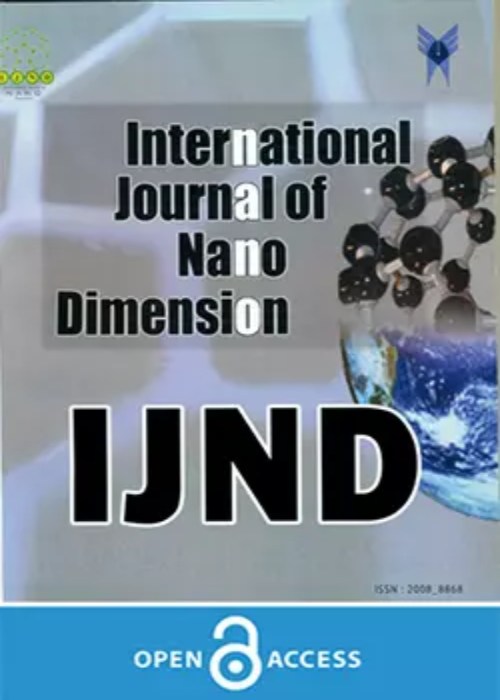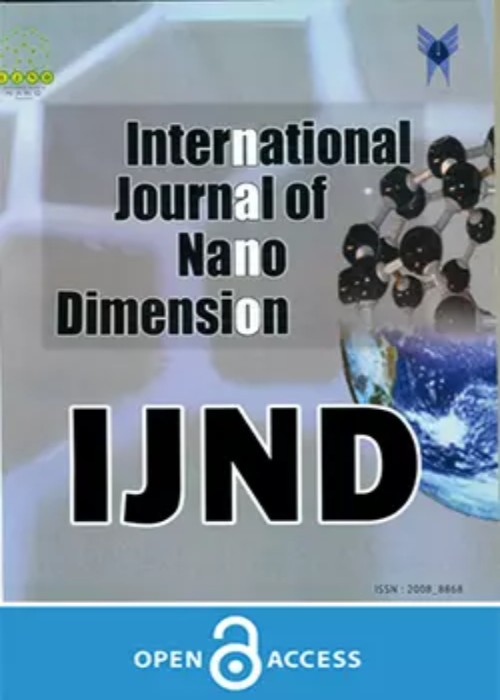فهرست مطالب

International Journal of Nano Dimension
Volume:14 Issue: 2, Spring 2023
- تاریخ انتشار: 1402/03/09
- تعداد عناوین: 8
-
-
Pages 115-125
Computational study plays an important role to discover the potential of the bio-inspired nano scale molecular devices. Density Functional Theory (DFT) is one of the popular methods to calculate the properties of the molecules which can not be possible with ab initio process, preferably for transition metals. This method is important for electronic structure calculation along with structure of molecules, atoms and solids can also be calculated using this DFT method. It is the quantitative method to understand the material properties using the laws of fundamental quantum mechanics. The key benefit of Non Equilibrium Greens’ Function (NEGF) is that it preserves the wave character of the electrons, which leads to a extremely precise description of nanoscale. Combining theses DFT and NEGF calculation first principle approach reveal the quantum-ballistic properties of atomic scale electronic structures which is therefore attracts the researchers for their innovative calculations for nano scale device modelling. In this paper, we briefly discuss the review on various bio-molecular devices and their significances. Now-a-days bio inspired devices show more attractions due to their versatility compared to the conventional electronic devices. These nano scale devices are popular due to their performance, speed and high charge transmission properties compared to other conventional semi-conductor devices. This review work presents some experimental works at the molecular level along with a variety of research works that are performed based on first principle approach. Several case studies prevails the importance of DFT and NEGF based first principle approach for nano scale device modelling.
Keywords: Bio-Molecular Device, DFT, First Principle, Nano Scale Device, NEGF -
Pages 126-137Metal oxide nanoparticles are capable of successfully inhibiting bacterial strains. Among the several transition metal atoms, iron (Fe) looks to be a viable dopant since iron oxide has been used a lot in biomedical research due to its biocompatibility and magnetic properties. In order to boost its antibacterial activity and facilitate the entry of nanoparticles into bacterial cells, Cd2SnO4 has been selectively doped with Fe. The chemical precipitation method was used to synthesize Cd2SnO4 and Fe-doped Cd2SnO4 nanoparticles toward antibacterial activity. To the best of our knowledge, there is no report is available on the antibacterial activity of undoped and Fe-doped cadmium stannate nanoparticles against salmonella typhi. The nanoparticles formed are in the cubic phase, according to the XRD results, the size of the crystallites is seen to grow as the increase in Fe concentrations. By using the good diffusion method, the antibacterial properties of synthesized nanoparticles were examined against two human pathogens, including staphylococcus aureus and salmonella typhi. Both undoped and Fe-doped Cd2SnO4 nanoparticles have antibacterial action that inhibits pathogen growth, according to antibacterial tests, which have shown the presence of a zone of clearing surrounding the well.Keywords: Cd2SnO4 Nanoparticles, Chemical precipitation, Fe Doped, S.aureus, SEM, S.typhi, XRD
-
Pages 138-144Recently, the synthesis of metal nanocrystallites using plant extracts has received much attention due to its low cost and compatibility with the environment. In this research, copper nanocrystallites were synthesized using hawthorn extract. The formation of copper nanocrystallites was observed by changing the color of the solution. Synthesized copper nanocrystallites were investigated by techniques such as: Ultraviolet-Visible Spectroscopy (UV-Vis), Scanning Electron Microscope (SEM), Fourier Transform-Infrared Spectroscopy (FTIR), Energy Dispersion Spectroscopy (EDX) and X-ray Diffraction Spectroscopy (XRD). In the UV-Vis spectrum, a dominant absorption peak at 552 nm wavelength was observed, which was related to copper nanocrystallites. In the images taken from SEM, it was found that the nanocrystallites are nearly spherical in shape and their average size on the surface of the sample was about 61-85 nm. Parallerly, in the investigation of antibacterial properties, synthesized nanocrystallites showed better antibacterial activity against Gram-negative bacteria (Escherichia coli) respect to other bacteria in the present work. The obtained results show that hawthorn extract can be used for the synthesis of copper nanocrystallites.Keywords: Antibacterial, Copper Nanocrystallites, Green synthesis, plant extract, X-ray Diffraction Spectroscopy (XRD)
-
Pages 145-156Cobalt vanadate (Co3V2O8) nanoparticles were prepared by a hydrothermal process using ammonia metavanadate and cobalt nitrate as precursors and calcined at 450 °C to obtain pure Co3V2O8 nanoparticles. The sample was characterized by scanning electron microscopy, X-ray diffraction, Fourier transform infrared, and UV-visible diffuse reflectance spectroscopy. The characterization analysis confirmed variations in the structure, shape, functional group, and energy gap of Co3V2O8 nanoparticles. Using the Tauc relationship, the energy band gap was determined by analyzing the Tauc curve. The nanoparticles obtained had an average size of 40 nm and found the zeta potential of the nanoparticles was -78 mV, indicating good dispersion and stability. The photocatalytic activity of Co3V2O8 nanoparticles through the degradation of malachite green dye was investigated under UV light irradiation. According to the results, Co3V2O8 nanoparticles showed a maximum removal efficiency of 89 percent in 60 minutes. It shows that synthesized Co3V2O8 nanoparticles have a strong potential for application as a photocatalyst to degrade textile dyes in wastewater treatment rapidly.Keywords: Cobalt Vanadate, Degradation, Hydrothermal synthesis, Malachite green, Photocatalyst, Wastewater treatment
-
Pages 157-166Euphorbia helioscopia, a traditional medicinal herb, possesses various pharmaceutical applications for human diseases. In the present study, the ethanol and hexane extracts of E. helioscopia leaves were subjected to phytochemical screening to identify the presence of secondary metabolites. The concentrations of alkaloids, phenols, and flavonoids were determined quantitatively to evaluate the medicinal properties of the plant extracts. The ethanolic extract showed a higher yield of various secondary metabolites, specifically, phenol showed a high degree of precipitation. Silver nanoparticles (AgNPs) were then green synthesized from the leaf extract and characterized by UV–Visible spectroscopy, Fourier Transform Infrared Spectroscopy (FTIR), and Scanning Electron Microscope (SEM). The presence of elemental silver is confirmed by the sharp peaks in the UV-Visible at 442 nm. The FTIR spectrum showed the presence of various functional groups from the plant extract that fabricated and activated the AgNPs. The synthesized NPs were found to be spherical with slight aggregation in the SEM micrograph. The crude plant extracts and AgNPs were compared for antibacterial activity at various concentrations. AgNPs exhibited higher inhibitory activity against selected Gram-positive and Gram-negative pathogens than the crude extracts. The enhanced activity of AgNPs may be attributed to the phenolic content of the plant extracts. Hence, the present study confirms that E. helioscopia leaves have potential antimicrobial activity and also act as an efficient source for AgNPs with remarkable pharmacological properties that can be further evaluated to develop them as a promising drug candidate.Keywords: AgNPs, Antibacterial activity, Euphorbia Helioscopia, phytochemicals, Quantification
-
Pages 167-177This research used an oven and spray drying method to dry nanofibrillated cellulose (NFC) and evaluates its effect on polylactic acid (PLA) nanocomposite properties. As shown by atomic force microscopy (AFM), the average size of nanocellulose in the spray-dried sample (NCSD) was 84-96 nm. However, the average size of nanocellulose obtained from oven drying was 647-697 µm. The average size of the NCSD sample indicates that spray drying kept nanocellulose in the nano-scale range after drying. A melting process was then used to reinforce the polylactic acid matrix with the spray and oven-dried nanocellulose. Compared to neat PLA and PLA-containing oven-dried forms of nanocellulose (PLA-NCOD), our results showed a significant improvement in the mechanical strength of nanocomposites containing PLA-NCSD. PLA-NCSD nanocomposite demonstrated greater thermal stability than neat PLA and PLA-NCOD when subjected to thermal analysis. This study clearly illustrates the comparative effect of spray-dried nanocellulose on reinforced nanocellulose/PLA composites.Keywords: Mechanical Properties, Nanocellulose drying, Nanofibrillated cellulose (NFC), Polylactic Acid, Thermal properties
-
Pages 178-190Rapid augmentation in the prevalence of multidrug-resistant (MDR) Staphylococcus aureus is a worldwide threat. Advising newer antibiotics may fail to reduce the chances of the emergence of newer drug-resistant Staphylococcus aureus. Very little shreds of evidence can be found to treat clinical MDR Staphylococcus aureus with biogenic silver nanoparticles (AgNPs) in West Bengal. To prepare AgNPs biogenically using aqueous tulsi leaf extract (TLE) and also to assess its antibacterial effect upon clinical MDR Staphylococcus aureus, biogenic synthesis of the AgNPs using aqueous TLE was done, characterized those with UV-Vis Spectrophotometer, dynamic light scattering, field emission scanning electron microscopy, Fourier transform infrared spectroscopy, and evaluated the antibacterial activity against the clinical MDR Staphylococcus aureus. ANOVA followed by LSD post hoc test was used to test the differences between the OD (optical density) of different experimental sets. The biosynthesized AgNPs were spherical, monodispersed, and of smaller size (9-23 nm) with the involvement of eugenol, quercetin, and oleanolic acid present in the tulsi leaf. A significant change in OD was observed in AgNPs (prepared using TLE) treated broth compared to only tulsi leaf extract treated culture. There was a significant similarity between the efficacies of AgNPs and clindamycin (P < 0.05). Our findings propose that AgNPs synthesized using TLE were fast and efficient to ameliorate the bacterial growth, which may be used as a potent antibacterial agent for the treatment of clinical MDR Staphylococcus aureus infection in near future.Keywords: Ag Nanoparticles, Biogenic, Clindamycin, MDR, MRSA, Staphylococcus aureus, Tulsi
-
Pages 191-202Nickel oxide (NiO) and cobalt doped Nickel oxide (Co-NiO) nanoparticles were successfully synthesized by cost effective, environmentally friendly, and scalable eco-precipitation method. The prepared nanoparticles were investigated by X-ray diffraction (XRD), Scanning electron microscopy (SEM), Energy dispersive X-ray analysis (EDAX), Fourier Transform Infrared Spectroscopy (FTIR), Optical spectroscopy (UV) and Cyclic voltammetric (CV). The structural characterization was carried out by X-ray diffraction which confirmed the polycrystalline nature of the particles with cubic structure. SEM analysis of the particles enabled the conclusion that the prepared particles were polycrystalline, irregularly spherical in shape, and agglomerated. The chemical bond and functional group were identified from FTIR spectroscopy and the elemental composition of prepared particles was identified by EDAX analysis. From UV-VIS absorbance spectra and Tauc relation, the type of transition and band gaps of the particles were estimated. The electrochemical performance was investigated using Cyclic Voltammetry (CV), Galvanostatic charge discharge (GCD), and Electrical Impedance Spectroscopy (EIS) in presence of 1M KOH as an electrolyte. The NiO and cobalt-doped NiO coated electrodes provide promising applications as electrode materials for energy storage devices.Keywords: Cobalt-Doped NiO, Cyclic voltammetry, Energy Storage Device, Nickel oxide nanoparticles, Supercapacitors


